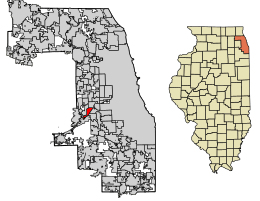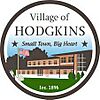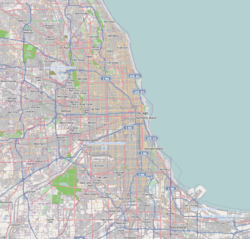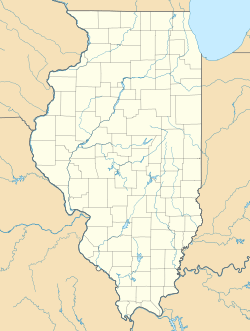Hodgkins, Illinois facts for kids
Quick facts for kids
Hodgkins, Illinois
|
||
|---|---|---|

The old Hodgkins Village Hall and Fire Station
|
||
|
||
| Motto(s):
"A progressive community based on family values"
|
||

Location of Hodgkins in Cook County, Illinois
|
||
| Country | United States | |
| State | Illinois | |
| County | Cook | |
| Area | ||
| • Total | 2.77 sq mi (7.16 km2) | |
| • Land | 2.71 sq mi (7.02 km2) | |
| • Water | 0.05 sq mi (0.14 km2) | |
| Population
(2020)
|
||
| • Total | 1,500 | |
| • Density | 553.10/sq mi (213.54/km2) | |
| Time zone | UTC-6 (CST) | |
| • Summer (DST) | UTC-5 (CDT) | |
| ZIP Code(s) |
60525
|
|
| Area code(s) | 708 | |
| FIPS code | 17-35385 | |
| Wikimedia Commons | Hodgkins, Illinois | |
Hodgkins is a village in Cook County, Illinois, United States. It's an industrial suburb located near Chicago. About 1,500 people lived there in 2020.
Hodgkins is home to the world's largest package sorting center. This huge facility is run by United Parcel Service (UPS) and is called CACH. It employs over 9,000 people!
On July 12, 2023, a strong tornado, rated EF2, moved through Hodgkins. It caused damage to trees in the Theodore Stone Forest Preserve. Several businesses and stores were also affected, including The Quarry Shopping Mall, Walmart, Kohl's, and Target. The tornado then moved into the Vulcan Quarry and continued towards McCook.
Contents
- About Hodgkins: Location and Neighbors
- People Living in Hodgkins: Demographics
- History of Hodgkins Village
- McCook-Hodgkins Enterprise Zone: Growing Business
- Immanuel Lutheran Church: A Community's Faith
- Fire Protection: Keeping Hodgkins Safe
- Hodgkins Today: Community Life
- Getting Around: Transportation
- See also
About Hodgkins: Location and Neighbors
Hodgkins is located at 41°45′51″N 87°51′34″W. It covers an area of about 2.77 square miles (7.16 square kilometers). Most of this area is land, with a small amount of water. The village is just over 3 miles (4.8 km) from Chicago's western edge.
The communities next to Hodgkins include Willow Springs, Justice, Bedford Park, McCook, and Countryside.
People Living in Hodgkins: Demographics
The number of people living in Hodgkins has changed over the years. Here's how the population has grown and shrunk:
| Historical population | |||
|---|---|---|---|
| Census | Pop. | %± | |
| 1900 | 195 | — | |
| 1910 | 480 | 146.2% | |
| 1920 | 266 | −44.6% | |
| 1930 | 302 | 13.5% | |
| 1940 | 331 | 9.6% | |
| 1950 | 536 | 61.9% | |
| 1960 | 1,126 | 110.1% | |
| 1970 | 2,270 | 101.6% | |
| 1980 | 2,005 | −11.7% | |
| 1990 | 1,963 | −2.1% | |
| 2000 | 2,134 | 8.7% | |
| 2010 | 1,897 | −11.1% | |
| 2020 | 1,500 | −20.9% | |
| U.S. Decennial Census | |||
In 2020, there were 1,500 people living in Hodgkins. The village had 690 households and 333 families. The population density was about 542 people per square mile.
Most residents were White (59.47%). There were also people who identified as African American, Native American, and Asian. A significant portion of the population, 44.13%, identified as Hispanic or Latino.
About 24.3% of households had children under 18. The average household had about 3.76 people. The median age in the village was 38.1 years old.
The median income for a household was $54,792. This means half of the households earned more than this, and half earned less. About 14.6% of the population lived below the poverty line.
History of Hodgkins Village
The first European explorers to visit the area were Jacques Marquette and Louis Joliet in 1673. They traveled down the Des Plaines River.
Early Settlement and the Canal
Real settlement began around 1836. Irish and Italian immigrants came to work on the Illinois and Michigan Canal. This canal was very important for forming many villages along its path, including Hodgkins. The I&M Canal is still there, about 1 mile south of Hodgkins. It's now a National Heritage Corridor, full of history, nature, and wildlife.
How Hodgkins Got Its Name
The village was first called Gary. Some say this name came from "Garibaldi", honoring the many Italian workers in a local grain mill. After a few name changes, the Village of Hodgkins was officially created in 1896.
The village was named after Jefferson Hodgkins. He was the president of the Kimball and Cobb Stone Company, the first business in the village. Modesto Lenzi became the village's first president that same year.
Jefferson Hodgkins: The Man Behind the Name
Jefferson Hodgkins was a quarryman and contractor. He was born in Maine in 1843. He worked as a sailor for eight years and even served in the American Civil War.
In 1872, he came to Chicago and later became a superintendent for a dredging company. In 1885, he started the Kimball and Cobb Stone Company. This company owned stone quarries and made crushed stone, mainly for railway work.
Hodgkins was also involved in social and political life. He served as an aide-de-camp (a personal assistant) for Illinois Governor Joseph W. Fifer.
The name "Hodgkins" replaced "Gary" when the village was incorporated in 1896. Before that, the area had other names too. The Potawatomi people lived there first. Later, it was called "Polk" and then "Novak" when a train station was built.
Today, quarrying still happens at the Vulcan Materials Company McCook Quarry, which covers 650 acres in Hodgkins and McCook.
McCook-Hodgkins Enterprise Zone: Growing Business
In the 1950s and 1960s, Hodgkins became a hub for motor freight companies. Its good location near expressways and flat land made it perfect for moving goods.
However, by the late 1970s, the motor freight industry started to slow down. To help the village grow again, Hodgkins teamed up with McCook in 1985. They created the McCook-Hodgkins Enterprise Zone. This zone offered special benefits to new businesses.
As a result, new businesses started to come to Hodgkins. In 1992, The Quarry Mall, a large shopping center, was built where old motor freight companies used to be. Car dealerships, restaurants, and a movie theater also opened. The biggest success of this zone was the United Parcel Service (UPS) package sorting facility, built in 1991.
Immanuel Lutheran Church: A Community's Faith
People in Hodgkins thought about starting a Lutheran church as early as the 1880s. Lutheran families living there had to travel to churches in La Grange or Willow Springs.
A local merchant, John Witsan, started a Sunday school in Hodgkins. This made families want a local church even more. In 1911, two representatives from the nearby Lutheran churches met with Reverend Alex Ullrich to discuss forming a new church.
Reverend Herman Meyer of Willow Springs supported the idea. He began holding the first Lutheran worship services in Hodgkins in the old Village Hall in the spring of 1911. On April 23, 1911, twenty-six men, along with Reverend Ullrich and Reverend Meyer, officially formed the Immanuel Evangelical Lutheran Church of Hodgkins, Illinois.
Fire Protection: Keeping Hodgkins Safe
For many years, Hodgkins had its own ways of fighting fires. In the early days, they had an organized bucket brigade. This was a group of people who would pass buckets of water to put out fires. They would gather when a large bell rang from the old Village Hall.
Later, Hodgkins had a Volunteer Fire Department. It had two full-time firefighters and other volunteers who operated three fire engines.
Since 1976, the Pleasantview Fire Protection District has served Hodgkins. This district started in 1946 with one fire engine. Now, it covers a large area in the southwest suburbs of Chicago. It has three fire stations:
- Station One: In La Grange Highlands. This is also the district's main office.
- Station Two: In Burr Ridge.
- Station Three: The newest station, located in Hodgkins.
These stations serve Hodgkins and nearby towns like Burr Ridge, Countryside, and Indian Head Park. The district has professional, full-time firefighters and paramedics for ambulances. They also work with other fire departments in the area to help each other during emergencies.
Hodgkins Today: Community Life
The village of Hodgkins has its own police department to keep everyone safe. It also has a public works department and a water department. The water department buys Lake Michigan water from McCook.
Younger students in Hodgkins attend Hodgkins Elementary School. Older students go to Lyons Township High School. The Hodgkins Park District offers a large community center with many activities all year. The Hodgkins Public Library is a full-service library that is part of a larger library system.
The village employs about 25 full-time and part-time staff members. Hodgkins news is covered by two local newspapers: the Suburban Life and the Desplaines Valley News.
Getting Around: Transportation
Pace provides bus service in Hodgkins. These bus routes connect the village to many other places in the region.
See also
 In Spanish: Hodgkins para niños
In Spanish: Hodgkins para niños





